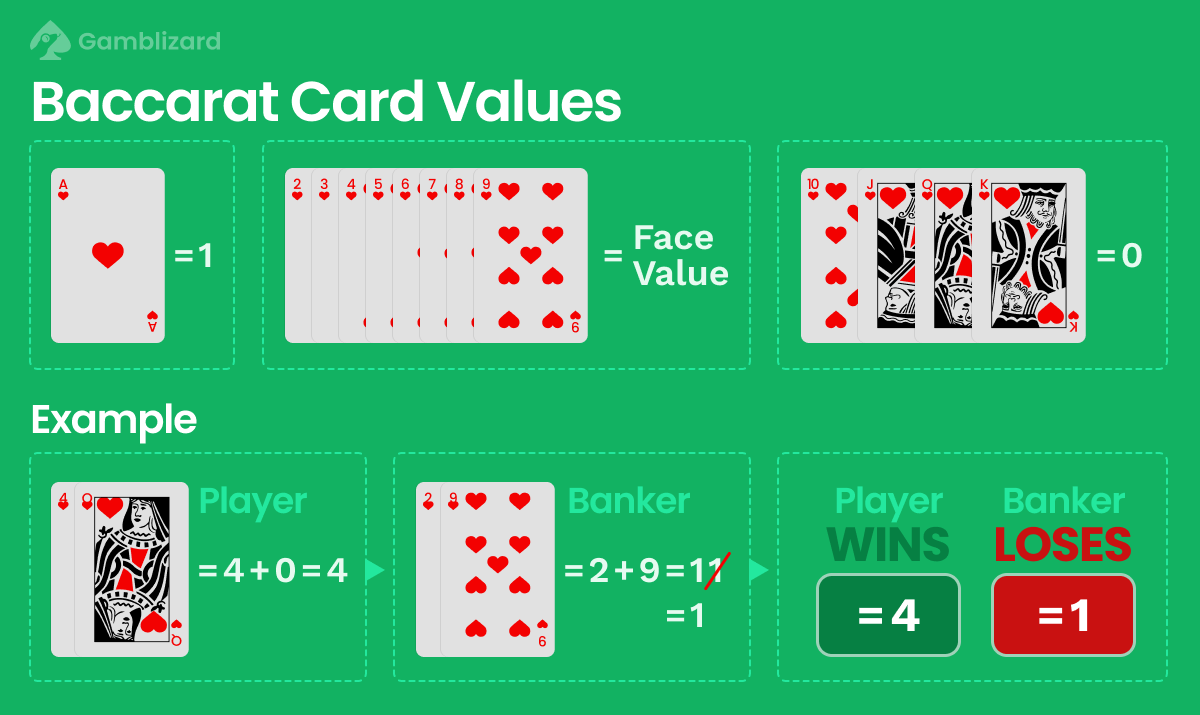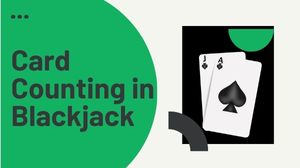How to Play Baccarat at Casinos
- Basic Game Rules of Baccarat
- Third Card Rule
- Winning in Baccarat: Understanding Winning Hands and Bets
- Tie in Baccarat
- Variations of Baccarat
- Different Betting Options
- Side Bets and Extra Games
- Commissions in Baccarat
- Best Bets in Baccarat
- RTP and Volatility
- Baccarat Strategies
- Baccarat Glossary: Master the Terms
- Tips and Cautions
- Baccarat vs. Blackjack
- Playing Baccarat at Online Casinos
Baccarat is an excellent casino card game for beginners because the rules are simple and quick to learn.
Even with multiple players at the table, the game usually involves just two parties: the player and the banker. In Baccarat Punto Banco, your task is not to draw cards or make decisions during the game. In other versions, the dealer role may rotate.
Regardless of which version of baccarat you play, the goal is to bet on whether the player, the banker, or a tie will win. Bets are placed on one of these three outcomes, and those who guess correctly are rewarded.
In this guide, we’ll explain the different baccarat rules clearly, go through the card values, necessary terms, and various tactics you can use while playing baccarat.
Basic Game Rules of Baccarat
The rules of baccarat table games do not vary much between different versions.
The game uses 6 or 8 standard 52‑card decks (3‑deck tables exist in Banque). Aces count as 1, 2–9 at face value, 10/J/Q/K as 0, and only the last digit of any total counts.
Below is how a round of baccarat progresses
Decide whether to place your bet on the player, the banker, or a tie. It doesn’t matter what your own cards are.
The dealer or a computer program deals two cards to both parties.
A third card is dealt if the player’s score is 0–5. The banker’s drawing rule depends on the cards of both the player and the banker.
The cards are revealed, and their points are totaled. The party closest to 9 wins. A tie is also possible.
If your bet is correct, you receive an amount corresponding to your stake and the payout ratio in your game account. A new round starts immediately.
Third Card Rule
The rules of baccarat include a situation where a third additional card is necessary. Its use is determined based on the values of the player’s and banker’s hands.
Below is when a third card is dealt to the player:
- If the player’s two-card value is 0–5, a third card is dealt.
- If the player’s two-card value is 6–7, no third card is dealt.
- If either hand totals 8 or 9 (‘Natural’), no further cards are drawn and the higher natural wins immediately.
Whether a third card is also drawn for the banker depends on the player’s cards.
Below we clarify when a third card is dealt to the banker:
- If the banker’s two-card value is 0–2, the banker draws a card regardless of the player’s third card value.
- If the banker’s two-card value is 3, the banker draws a card unless the player’s third card is an 8.
- If the banker’s two-card value is 4, the banker draws a card if the player’s third card value is 2, 3, 4, 5, 6, or 7.
- If the banker’s two-card value is 5, the banker draws a card if the player’s third card value is 4, 5, 6, or 7.
- If the banker’s two-card value is 6, the banker draws a card if the player’s third card value is 6 or 7.
- If the banker’s two-card value is 7, the banker does not draw a third card.
Winning in Baccarat: Understanding Winning Hands and Bets
In Baccarat, it’s important to distinguish between a winning hand and a winning bet. If the player wins the round but you didn’t bet on them, you lose your bet. In versions of Baccarat where the banker’s role changes, whether a round is successful depends on who you bet on.
The winning hand is determined when the points of the cards are totalled. The best possible outcome is a score of 9 with two cards, known as “Le Grande,” or 8, known as “Le Petite.” Both are also referred to as “Natural,” and a win is guaranteed unless the dealer’s cards result in a tie. Otherwise, the highest score wins.
In scoring, it’s important to note that if the total exceeds 9, the first digit is dropped. For example, a score of 18 becomes 8, 12 becomes 2, and so on.
Tie in Baccarat
A tie in Baccarat occurs when the player’s and banker’s hand values are equal after two or three cards. For instance, if both the player and banker have a hand value of 7, it’s a tie.
Baccarat rules provide different procedures for resolving a tie. Players who bet on the player or banker get their bets back, as neither wins nor loses.
Players who bet on a tie and guess correctly are rewarded. The payout for a tie bet is either 8:1 or 9:1, depending on the casino’s rules.
After a tie, the cards are collected and shuffled, and a new round begins.
Variations of Baccarat
Baccarat is one of the most popular casino games, with several interesting variations.
Each variation differs slightly in terms of the number of decks used, the role of the dealer, and the third card rules. However, the way of winning and scoring of cards remains the same in all versions.
Below, explore some of the most popular variations of Baccarat, such as Punto Banco, Chemin de Fer, and Baccarat Banque.
Punto Banco
Punto Banco is the most common version of Baccarat, and its rules have been covered above. Players do not make active decisions during the game; all actions are determined by predefined rules.
The player and banker each receive two cards. A third card is automatically dealt if the player’s score is 0–5. The banker receives a third card depending on both their own and the player’s cards.
The game uses eight decks, and the cards are dealt face-to-face on the table. Various betting options are possible, and the rules for these are explained in detail in the instructions for each game.
Punto Banco’s banker bet has one of the lowest house edges of all casino games.
Chemin de Fer
Chemin de Fer, also known as French Baccarat, is a version where players compete against each other. One player assumes the role of the banker and places a wager on the table. The other players’ bets can total up to the banker’s stake at most.
The casino takes a percentage of the winnings as a “commission” to guarantee it also profits. After bets are placed, the game round starts with the player who has the highest wager.
Additionally, Chemin de Fer is played with six decks instead of eight. The rules for when a player receives a third card also differ from those in Punto Banco. While in the basic version, a player gets a third card with a hand of 0–5, in Chemin de Fer, a new card is dealt if the hand is 0–4. Uniquely, if the hand value is 5, the player can choose whether to take a third card.
If the player takes a third card, the banker can also decide to draw a third card.
If the banker wins, their role continues. The banker’s winnings stay on the table and increase the stake size. If the banker loses, the role moves to the next player, who becomes the banker.
Being a banker can yield larger winnings than being a player, but there is also a greater risk as you can be betting against multiple players at once.
Baccarat Banque
Baccarat Banque, favoured by high rollers, allows the player with the highest table bet to act as the banker, giving them the potential to win – or lose – more money than if playing as a regular player.
Once the banker is chosen, the role remains with them throughout the game unless challenged by another player matching the bets. Another opportunity for a banker change occurs if the banker runs out of funds during the game.
Another key difference in Baccarat Banque compared to other variations is that it is played with only three decks instead of six or eight.
An additional hand is also dealt. Players receive two hands from which they can choose on which to place their bets.
If neither the player nor the banker has an 8 or 9, the player decides whether to take a third card.
After all hands are played, the cards are revealed. If either hand results in a tie, the funds remain on the table and are paid out in the next hand depending on which hand wins. In Baccarat Banque, bets on a tie are not possible.
The role of the banker, playing two hands, and the use of three decks add a tactical dimension to the game.
Different Betting Options
Exclusive baccarat tables at online casinos and easily escalating bets reinforce baccarat’s reputation as a trusted game for players with significant bankrolls.
Additionally, baccarat’s simple rules and minimal need for strategy make it appealing for those looking to focus on playing large sums without complex decisions.
Betting limits vary by casino and by table, with the minimum bet for live baccarat sometimes as low as 1$. RNG baccarat can be played for stakes as small as 0.10$.
Although the maximum bet at VIP tables can exceed 25,000$, not all players take advantage of this. The bankroll and budget are personal choices, and high bets are not mandatory.
At the baccarat table, bets are placed on the banker, player, or a tie. There are also side bets, such as Player Pair.
Side Bets and Extra Games
In addition to different versions, baccarat includes side bets that add extra excitement and winning opportunities to the game.
Remember that side bets and extra games are optional, and players can choose whether to place them in addition to the main bet. It is advisable to carefully read through the rules of each extra game before participating.
For instance, side bets available in Evolution Gaming’s Live Baccarat and Playtech’s Baccarat include:
- Player Pair: The player’s first two cards form a pair. Payout: 11:1
- Banker Pair: The banker’s first two cards form a pair. Payout: 11:1
- Perfect Pair: Either the player’s or banker’s first two cards form a pair of the same value and suit. Payout: 25:1
- Either Pair: Either the player’s or banker’s first two cards form a pair. Payout: 5:1
- Dragon Bonus: The winning hand wins by a certain number of points over the other. Payout ranges from 1:1 for a 4-point difference to 30:1 for a 9-point difference.
- Super 6 Insurance: The banker scores a 6. Payout: 15:1
These additional betting options provide layers of strategy and potential rewards for players.
Commissions in Baccarat
Since the banker bet in baccarat is statistically the most common, casinos impose a 5% commission on it. An exception is Evolution’s No Commission Baccarat, where players only receive half their original bet back when the banker scores 6 points.
Keep in mind, different baccarat games may include additional fees. It’s important to read the rules before starting to play, even though the fees are displayed on the game screen.
For example, Peek Baccarat imposes a 20% fee when you place a bet on either the player or the banker. Golden Wealth Baccarat charges a 20% Golden Card fee on each player’s bet. The highest extra fee, 50%, is found in XXXtreme Lightning Baccarat.
Best Bets in Baccarat
Baccarat is a game of chance, but statistically, the banker bet is more favourable than the player bet or a tie. The banker bet wins about 45.86% of the time, and its house edge is only about 1.06%. The player bet is a close second with a theoretical win rate of 44.62% and a house edge of 1.24%.
On the other hand, the tie bet should be avoided unless you are attracted by high risk. The offered payout of 8:1 or 9:1 is misleading because the house edge in this case is as high as 14.36%.
The probability of hitting a tie is only about 9.52%, making it the worst bet in terms of winning chances.
RTP and Volatility
RTP, or Return to Player, describes how much a game pays back to players over the long term.
In baccarat, RTP varies depending on which outcome the player bets on:
- Banker Bet: The RTP is about 98.94%. This is the highest RTP in baccarat, as the banker’s hand wins slightly more often than the player’s hand. However, the 5% commission on the banker’s bet affects the RTP.
- Player Bet: The RTP is about 98.76%. The player’s hand wins slightly less often than the banker’s hand, but there is no commission on this bet.
- Tie Bet: The RTP is significantly lower, usually about 85.64%. Ties happen infrequently, making this bet less profitable over the long term despite the large potential payout (8:1 or 9:1).
Baccarat Strategies
Baccarat is a game of luck, and no strategies or baccarat guides can guarantee a certain win. However, betting strategies like Martingale, Paroli, or Fibonacci can be used to manage your bankroll and potentially improve your game results.
The idea is to maximize wins and minimize losses. This often involves increasing or decreasing the bet amount following certain outcomes.
For example, in the Martingale system, a player doubles their bet after each loss until they win. Once they win, they return to their original bet size.
Players have limited ability to influence RTP and volatility since baccarat is based on randomness and predefined rules.
Statistically, the best long-term strategy in baccarat is to bet on either the banker or the player. Although the tie bet offers an attractive payout, its RTP is significantly lower, making it a poorer choice in the long run.
Baccarat Glossary: Master the Terms
A full understanding of baccarat requires knowledge of the game’s key terms and concepts.
A baccarat glossary can help you play different versions of baccarat online and speed up the time it takes to learn the rules.
See the most common baccarat terms below.
| Baccarat Term | Explanation |
|---|---|
| Baccarat Banque | A baccarat variant where players can bet on either hand. |
| Banco | Banker or bank, usually refers to the one dealing the cards. |
| Chemin de Fer | A baccarat variant where players take turns being the banker. |
| Mini Baccarat | A smaller version of baccarat with lower betting limits. |
| Natural | A hand where the first two cards total 8 or 9. |
| Punto | Player, the counterpart to the banker. |
| Side Bet | An additional bet players can place on top of the main bet, like “Pair” or “Perfect Pair.” |
| Squeeze | Slow revealing of the cards to increase suspense. |
| Tie / Stand-off / Push | A tie, a situation where the player’s and banker’s hands are of equal value. |
Tips and Cautions
Baccarat is a perfect game for new and beginning casino players. No prior experience or skills are required; just a keen interest in the game.
However, keep the following tips and cautions in mind when you start playing baccarat:
- Set a budget for yourself and stick to it rigorously. Only play with money you can afford to lose.
- Make sure you know the rules of the baccarat version you choose.
- Find out the casino’s betting limits in advance so you can choose a table that suits you.
- Play for free first to learn the baccarat rules.
- Take advantage of casino bonuses and promotions, but read the terms carefully.
Baccarat vs. Blackjack
Baccarat and blackjack are two popular casino games. They share similarities in playing against the dealer and the variety of betting options available.
The differences lie in the number of decisions made during the game, the payout structure, the house edge, and the RTP. Baccarat offers simpler and more straightforward gameplay, while blackjack has better theoretical winning possibilities.
Below is a comparison of Baccarat and Blackjack to help you draw your own conclusions.
| Casino Card Game | Baccarat | Blackjack |
|---|---|---|
| Complexity | Fewer decisions, more randomness | Many decisions during the round |
| Minimum Bets | $0.10–$1 | $0.10–$1 |
| Highest Payout | 9:1 or 8:1 | 3:2 |
| RTP (Return to Player) | Banker bet: 98.94%, Player bet: 98.76%, Tie: 85.64% | Varies with strategy, typically between 99% and 99.5% |
| House Edge | Banker: 1.06%, Player: 1.24%, Tie: 14.36% | Varies from 0.5% to 1% with optimal strategy |
| Player Interaction | Played against the dealer | Played against the dealer |
Playing Baccarat at Online Casinos
We know the best and most trustworthy casinos like the back of its hand. Our site’s team consists of seasoned casino industry professionals who conduct thorough research and rigorously evaluate each casino before making recommendations.
We check the casino’s licenses, security practices, game selection, bonus offers, and customer service quality to guarantee that our players get the best gaming.
We only trust casinos that meet the highest quality standards and offer fair and safe gaming.















